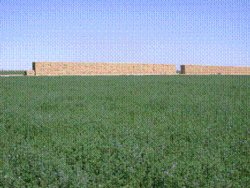DEVELOPMENT
Moapa 69 was released jointly by the Nevada and California Experiment Stations and the USDA in 1970 as a replacement for Moapa in areas of Utah, Nevada, and California where Moapa was grown. It is a purple flowered, vigorous, upright growing, non-winter hardy synthetic variety with resistance to spotted alfalfa aphid. It recovers rapidly after cutting and persists well.
BREEDING HISTORY AND DESCRIPTION
Two of the parent clones of Moapa were replaced by two widely tested clones known to have better performance. The nine parent clones of Moapa 69 are C904, C906, C907, C908, C909, and C910 from Moapa, C937 from Sonora and El-Unico, and C1026 from Mesa Sirsa and El-Unico.
ADAPTATION
Moapa 69 is intended for hay production in those areas of Utah, Nevada, Arizona, and California were Moapa was grown.
PEST AND DISEASE RESISTANCE
Moapa 69 is highly resistant to the spotted alfalfa aphid. It is somewhat resistant to bacterial wilt.
FORAGE YIELD DATA
Forage yields of Moapa 69 were superior to Moapa.
SEED CLASSES AND PRODUCTION
Breeder seed is a composite of equal amounts from each of the nine parent clones intercrossed under isolation. Seed classes are breeder, foundation, and certified. Foundation seed is the first generation seed increase of breeder seed from fields planted at elevations below 2500 feet and south of the 40o parallel in California, Nevada, and Arizona. Length of stand for foundation seed production shall not exceed 5 years from date of seeding. Certified seed is the production from fields planted with either foundation or breeder seed. No other seed class or generation is to be certified. Parental clones and breeder seed will be maintained by Nevada Agricultural Experiment Station.